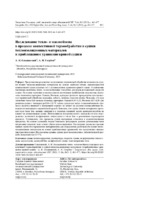| dc.contributor.author | Ольшанский, А. И. | |
| dc.contributor.author | Голубев, А. Н. | |
| dc.coverage.spatial | Минск | ru |
| dc.date.accessioned | 2023-11-15T11:09:24Z | |
| dc.date.available | 2023-11-15T11:09:24Z | |
| dc.date.issued | 2023 | |
| dc.identifier.citation | Ольшанский, А. И. Исследование тепло- и массообмена в процессе конвективной термообработки и сушки теплоизоляционных материалов и приближенное уравнение кривой сушки = Investigation of Heat and Mass Transfer in the Process of Convective Heat Treatment and Drying of Thermal Insulation Materials and Approximate Equation of the Drying Curve / А. И. Ольшанский, А. Н. Голубев // Известия высших учебных заведений и энергетических объединений СНГ. Энергетика. – 2023. – № 5. – С. 461-477. | ru |
| dc.identifier.uri | https://rep.bntu.by/handle/data/137302 | |
| dc.description.abstract | Представлены результаты исследования термической обработки в процессах сушки тонких теплоизоляционных материалов на основе наиболее общих закономерностей конвективной сушки влажных тел с установлением уравнения кривой сушки. Установлены численные величины тепло- и массообменных чисел Био для периода падающей скорости сушки. На основе изучения и анализа многих источников приближенно определены диапазоны изменения критериев Лыкова, Поснова, критерия фазового превращения для процессов термической обработки керамики, асбеста, войлока, пластин глины. Показано, что при значениях чисел Био меньше единицы, критериев Лыкова 0,05–0,13, Поснова 0,03–0,08 для режимов сушки с температурой 90–120 °C задача сушки как тепло- и массообменного процесса является внешней и внутренний перенос не влияет на условия взаимодействия поверхности материала с окружающей средой. Показано, что сушка тонких материалов протекает при числе Био меньше единицы и в условиях внешней задачи критерии подобия не влияют на конвективную сушку. Интенсивность испарения влаги с поверхности тела определяется величиной коэффициента теплоотдачи в числе Био и режимными параметрами процесса. Установлено, что процессы сушки материалов относятся к малоинтенсивным процессам. На основе элементов теории теплового регулярного режима установлены темп нагревания влажного тела и темп убыли влагосодержания. Рассмотрена задача построения кривых сушки без проведения экспериментов для определения длительности сушки теплоизоляционных материалов на основе приближенных уравнений, что представляет интерес для практики сушки. Построенные кривые сушки дают несовпадение с действительной кривой с погрешностью 4–5 %. | ru |
| dc.language.iso | ru | ru |
| dc.publisher | БНТУ | ru |
| dc.title | Исследование тепло- и массообмена в процессе конвективной термообработки и сушки теплоизоляционных материалов и приближенное уравнение кривой сушки | ru |
| dc.title.alternative | Investigation of Heat and Mass Transfer in the Process of Convective Heat Treatment and Drying of Thermal Insulation Materials and Approximate Equation of the Drying Curve | ru |
| dc.type | Article | ru |
| dc.identifier.doi | 10.21122/1029-7448-2023-66-5-461-477 | |
| local.description.annotation | The results of the study of heat treatment in the drying processes of thin thermal insulation materials based on the most general laws of convective drying of wet bodies with the establishment of the equation of the drying curve are presented. The numerical values of heat and mass transfer Biot numbers for the period of decreasing drying rate are established, too. Based on the study and analysis of numerous sources, the ranges of changes in the Lykov, Posnov, and phase transformation criteria for the processes of heat treatment of ceramics, asbestos, felt, and clay plates have been approximately determined. It is demonstrated that for values of Biot numbers less than one, for Lykov criteria value of 0.05–0.13 and for Posnov criteria value of 0.03–0.08 for drying modes with a temperature of 90–120 ° C, the task of drying, as a heat and mass transfer process, is external, and internal transfer does not affect the conditions of interaction of the material surface with the environment. It is also shown that the drying of thin materials takes place when the Biot number is less than one and, under the conditions of an external problem, the similarity criteria do not affect convective drying. The intensity of moisture evaporation from the body surface is determined by the value of the heat transfer coefficient in the Biot number and the regime parameters of the process. It has been established that the processes of drying materials are lowintensity processes. Based on the elements of the theory of thermal regular regime, the rate of heating of a wet body and the rate of decrease in moisture content are determined. The problem of constructing drying curves without conducting experiments to determine the duration of drying of thermal insulation materials based on approximate equations is considered; this problem is of interest for the practice of drying. The constructed drying curves do not coincide with the actual curve with an error of 4–5 %. | ru |

